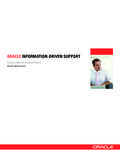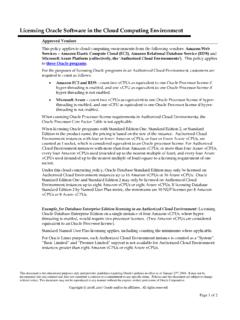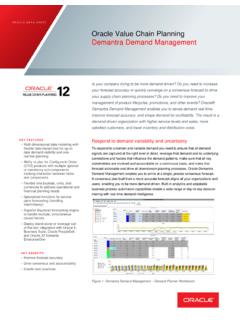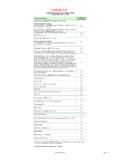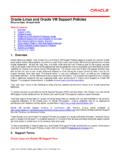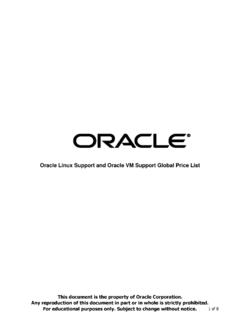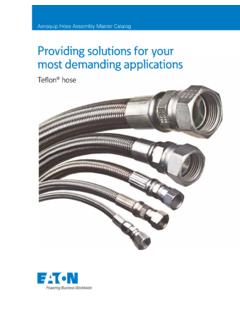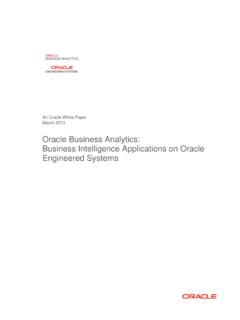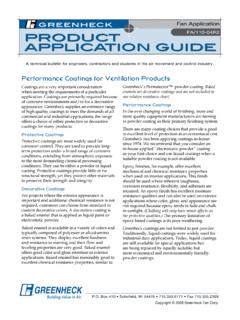Transcription of Building Trading Applications using the Oracle Extreme ...
1 An Oracle White Paper August 2011 PERFORMANCE, TIME TO MARKET, SUSTAINABILITY Building Trading Applications using the Oracle Extreme Java Trading Platform Building Trading Applications using the Oracle Extreme Java Trading Platform 1 Introduction Increasingly, the key differentiator between electronic Trading market participants is the speed at which they can process market data into opportunities, executed orders, and fills; so the performance of their Trading platforms is key to success. Fundamental to both market venues and Trading firms is minimizing latency across the entire trade execution process. Applications performing specific functions such as market data handling, algorithmic Trading , execution management, order routing, and connectivity are typically created as a number of functional modules which are physically distributed across a series of servers, or run on a single multi-core server.
2 The optimal architecture is determined by analysis of the application itself. Traditionally, there has been a truism of software development if you build it quickly, it runs slowly , the corollary being that if you want your application to run fast then you had better invest significant time writing it in C++, and in tuning and optimisation. In the world of Trading , where getting the algo onto the desk as quickly as possible is vital, firms are searching for technologies which can alleviate this paradox how to build Applications quickly that run fast. The 80:20 Pareto rule applies inasmuch as it takes a disproportionate amount of time, effort, and specialist knowledge to extract that last little bit of performance and by extension, cost. Many firms have mitigated this by buying innovative technologies from early stage software and hardware vendors for innovative and early stage, read risky and difficult to integrate and support.
3 Furthermore, the firms themselves have no choice but to take on the integration risk the effort of making so many technologies with heterogeneous APIs work together as a single, high performance, unbreakable whole. Whilst performance is at the top of the list, these firms live according to the principles of Alpha - the relationship between risk and reward. Regardless of the promises of available performance, running what is essentially a technology business on top of risky technology cannot be contemplated. Also, the realities of life in an investment bank are such that cost is always front of mind. Consequently it is important to understand the realities of how fast the Trading application really needs to be. It is certainly true that not all requirements are equal so the extent to which the Trading The Oracle Extreme Java Trading Platform is an engineered system with a unique combination of technologies that allow developers to quickly build high performance Trading Applications that are low latency, deterministic, and can be deployed rapidly Building Trading Applications using the Oracle Extreme Java Trading Platform 2 application needs to exhibit Extreme performance can make a huge difference to the costs and risks associated with the technology platform.
4 For example, whilst some Options Trading and Arbitrage Applications may need to give microsecond and millisecond latency to be competitive, most latency sensitive Applications can be competitive with performance at around 10 milliseconds. Clearly the kind of technology required to achieve deterministic 1 microsecond performance is significantly different, and more expensive to achieve, than that required for 10ms. Trading System Requirements Given the development and challenges of the electronic Trading landscape, one can derive a shortlist of requirements for the technology platforms that will address those challenges: High performance, high throughput, and low latency. Deterministic and consistent performance in terms of latency. High availability and resilience.
5 Fast to deploy, easy to maintain and upgrade. Minimal number of moving parts to test and re-test. Easy to integrate with existing and proprietary technologies and Applications . Low TCO, including power/cooling/space and management. Small physical footprint for deployment in Co-Lo sites. Building Trading Applications using the Oracle Extreme Java Trading Platform 3 Java Performance Whilst the latency characteristics and performance of electronic Trading Applications are paramount, there are trade-offs that architects and developers must keep in mind. There is little point in Building the world s fastest algorithm if the opportunity to capitalize on the market innovation has already passed before the algo is finally ready to deploy. Equally, it makes no sense to develop the fastest application if it cannot be easily and quickly adapted to address the next Trading opportunity as the market changes.
6 So flexibility and time to market are considerations that must be treated as seriously as raw performance. It is estimated that more than 80% of electronic Trading Applications are written in Java. The reason that this phenomenon has arisen is that the Java platform offers the best balance between performance, speed of application development, and ease of flexibility and deployment. Amongst the most significant examples is the fact that nearly all of the FIX engines in the world are written in Java. It is also true that well written Applications in Java should be every bit as performant as those written in C++ or any other language. Controlling the ways in which Garbage Collection impacts latency and determinism is a consideration that the programmer must take direct responsibility for, assisted by the features of the Java Virtual Machine.
7 The dynamic run-time compilation optimisations that the Java VM offers can, in many cases, result in programs that exhibit better performance than those statically compiled by a C++ compiler. Architecture and Performance InfiniBand Network Communications Trading Applications are typically architected in a distributed fashion with different modules connected using high-speed network interconnects for exchanging messages. This messaging either takes place on a message bus , which is a specialist infrastructure component built for messaging, or using a data grid that does the messaging for you. Either way, distributed Trading apps require the conversation and chatter between the modules to be extremely high performance. Essentially, at the heart of any Trading application sits a high performance network; a scalable network which enables high-speed communication between constituent Applications and components.
8 Ethernet combined with TCP/IP has long been the standard networking stack within datacenters, but for low latency Applications Infiniband (IB) technology is fast becoming the networking fabric of choice. This is because it is extremely fast and absolutely deterministic, which is not true of Ethernet and TCP/IP. Infiniband today offers raw bandwidth rates of 40Gb/sec (QDR IB) and latencies typically in the order of a few microseconds. A key difference between IB and TCP/IP is that the IB architecture allows Applications direct access to the underlying messaging service by bypassing the operating system (OS) kernel and networking stack using a technique commonly referred to as kernel bypass . Message processing in IB is not done by the Building Trading Applications using the Oracle Extreme Java Trading Platform 4 CPU and OS but by IB networking software and hardware interface, which are called an HCA.
9 With the OS and CPU freed from having to process network traffic, more compute cycles are available to do application related tasks. Not only is the CPU freed up, but also memory bandwidth, often times a more constrained resource than CPU cycles, that would otherwise have been allocated for processing network IO. In a typical TPC/IP network, each inbound packet is placed in placed in an anonymous OS buffer pool and then copied to the application s virtual memory. A single 10Gb/s Ethernet link can thus consume more than 20 Gb/S of memory bandwidth. IB has a Zero Copy architecture and memory bandwidth and message latencies are drastically cut because messages do not need be copied between OS memory buffers and application buffers. It s important to note that although the OS is bypassed, IB architecture ensures that Applications have the same degree of isolation and protection that an operating system would otherwise provide, and it even provides for higher networking Quality of Service (QoS) management than a typical OS would provide.
10 Another difference between TCP/IP and IB technologies is that TCP/IP is a stream-based protocol where as IB is block or message based. While TCP/IP transmits packets of data and notifies the receiving application on receipt of each transmitted package, Infiniband software and hardware does not notify the receiving application until the entire message has been received and assembled. This vastly simplifies the interactions between the application and the networking stack and reduces the number of interrupts that the OS and application must process. In addition to sending and receiving messages, Infiniband allows Applications to directly and securely read from and write to the virtual memory of other Applications , even Applications running on remote servers.

